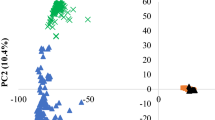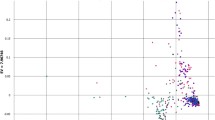Abstract
There are few reports of the patterns of polymorphism in the non-coding regions of plant genomes. In this study, we explored nucleotide diversity and linkage disequilibrium (LD) in 47 non-coding regions on chromosome 4 of wild and cultivated rice. The cultivated rice retained about 70% of the diversity of wild rice, which was verified by coalescent simulations with one population bottleneck for 198 combinations of duration and population sizes. Multi-locus likelihood analysis showed that the severity of the bottleneck ranged from 2.25 to 3.33, with an average value of 2.70; i.e., the diversity found in the cultivated rice could be explained by a founding population of 2,700 individuals if the initial domestication event occurred over a period of 1,000 years. LD decreased more rapidly in wild rice than in cultivated rice within 10 kb, and the LD observed in cultivated rice was increased at 100–140 kb by comparison with wild rice. The patterns of LD indicated the possibility of a haplotype block in cultivated rice but not in wild rice.






Similar content being viewed by others
Abbreviations
- LD:
-
Linkage disequilibrium
- SNP:
-
Single nucleotide polymorphism
References
Altschul SF, Madden TL, Schaffer AA et al (1997) Gapped BLAST and PSI-BLAST: a new generation of protein database search programs. Nucleic Acids Res 25:3389–3402
Barrett JC, Fry B, Maller J et al (2005) Haploview: analysis and visualization of LD and haplotype maps. Bioinformatics 21:263–265
Brown GR, Gill GP, Kuntz RJ et al (2004) Nucleotide diversity and linkage disequilibrium in loblolly pine. Proc Natl Acad Sci USA 101:15255–15260
Buckler ESt, Thornsberry JM, Kresovich S (2001) Molecular diversity, structure and domestication of grasses. Genet Res 77:213–218
Caicedo AL, Williamson SH, Hernandez RD et al (2007) Genome-wide patterns of nucleotide polymorphism in domesticated rice. PLoS Genet 3:1745–1756
Caldwell KS, Russell J, Langridge P et al (2006) Extreme population-dependent linkage disequilibrium detected in an inbreeding plant species, Hordeum vulgare. Genetics 172:557–567
Clark RM, Linton E, Messing J et al (2004) Pattern of diversity in the genomic region near the maize domestication gene tb1. Proc Natl Acad Sci USA 101:700–707
Dawson E, Abecasis GR, Bumpstead S et al (2002) A first-generation linkage disequilibrium map of human chromosome 22. Nature 418:544–548
Ewing B, Green P (1998) Base-calling of automated sequencer traces using phred. II. Error probabilities. Genome Res 8:186–194
Ewing B, Hillier L, Wendl MC et al (1998) Base-calling of automated sequencer traces using phred. I. Accuracy assessment. Genome Res 8:175–185
Eyre-Walker A, Gaut RL, Hilton H et al (1998) Investigation of the bottleneck leading to the domestication of maize. Proc Natl Acad Sci USA 95:4441–4446
Flint-Garcia SA, Thornsberry JM, Buckler ESt (2003) Structure of linkage disequilibrium in plants. Annu Rev Plant Biol 54:357–374
Garris AJ, McCouch SR, Kresovich S (2003) Population structure and its effect on haplotype diversity and linkage disequilibrium surrounding the xa5 locus of rice (Oryza sativa L.). Genetics 165:759–769
Gordon D, Abajian C, Green P (1998) Consed: a graphical tool for sequence finishing. Genome Res 8:195–202
Gupta PK, Rustgi S, Kulwal PL (2005) Linkage disequilibrium and association studies in higher plants: present status and future prospects. Plant Mol Biol 57:461–485
Heuertz M, De Paoli E, Kallman T et al (2006) Multilocus patterns of nucleotide diversity, linkage disequilibrium and demographic history of norway spruce [Picea abies (L.) Karst]. Genetics 174:2095–2105
Hey J, Wakeley J (1997) A coalescent estimator of the population recombination rate. Genetics 145:833–846
Hudson RR (2000) A new statistic for detecting genetic differentiation. Genetics 155:2011–2014
Hudson RR (2001) Two-locus sampling distributions and their application. Genetics 159:1805–1817
Hudson RR (2002) Generating samples under a Wright–Fisher neutral model of genetic variation. Bioinformatics 18:337–338
International Rice Genome Sequencing Project (2005) The map-based sequence of the rice genome. Nature 436:793–800
Khush GS (1997) Origin, dispersal, cultivation and variation of rice. Plant Mol Biol 35:25–34
Liu A, Burke JM (2006) Patterns of nucleotide diversity in wild and cultivated sunflower. Genetics 173:321–330
Londo JP, Chiang YC, Hung KH et al (2006) Phylogeography of Asian wild rice, Oryza rufipogon, reveals multiple independent domestications of cultivated rice, Oryza sativa. Proc Natl Acad Sci USA 103:9578–9583
Ma J, Bennetzen JL (2004) Rapid recent growth and divergence of rice nuclear genomes. Proc Natl Acad Sci USA 101:12404–12410
Morrell PL, Toleno DM, Lundy KE et al (2005) Low levels of linkage disequilibrium in wild barley (Hordeum vulgare ssp. spontaneum) despite high rates of self-fertilization. Proc Natl Acad Sci USA 102:2442–2447
Nordborg M, Borevitz JO, Bergelson J et al (2002) The extent of linkage disequilibrium in Arabidopsis thaliana. Nat Genet 30:190–193
Nordborg M, Hu TT, Ishino Y et al (2005) The pattern of polymorphism in Arabidopsis thaliana. PLoS Biol 3:e196
Pritchard JK, Stephens M, Donnelly P (2000) Inference of population structure using multilocus genotype data. Genetics 155:945–959
Remington DL, Thornsberry JM, Matsuoka Y et al (2001) Structure of linkage disequilibrium and phenotypic associations in the maize genome. Proc Natl Acad Sci USA 98:11479–11484
Roselius K, Stephan W, Stadler T (2005) The relationship of nucleotide polymorphism, recombination rate and selection in wild tomato species. Genetics 171:753–763
Rozas J, Sanchez-DelBarrio JC, Messeguer X et al (2003) DnaSP, DNA polymorphism analyses by the coalescent and other methods. Bioinformatics 19:2496–2497
Rozen S, Skaletsky H (2000) Primer3 on the WWW for general users and for biologist programmers. Methods Mol Biol 132:365–386
Second G (1982) Origin of the genic diversity of cultivated rice (Oryza spp.): study of the polymorphism scored at 40 isozyme loci. Jpn J genet 57:25–57
Sun CQ, Wang XK, Li ZC et al (2001) Comparison of the genetic diversity of common wild rice (Oryza rufipogon Griff.) and cultivated rice (O. sativa L.) using RFLP markers. Theor Appl Genet 102:157–162
Tajima F (1989) Statistical method for testing the neutral mutation hypothesis by DNA polymorphism. Genetics 123:585–595
Tang T, Lu J, Huang J et al (2006) Genomic variation in rice: genesis of highly polymorphic linkage blocks during domestication. PLoS Genet 2:e199
Tanksley SD, McCouch SR (1997) Seed banks and molecular maps: unlocking genetic potential from the wild. Science 277:1063–1066
Tenaillon MI, Sawkins MC, Long AD et al (2001) Patterns of DNA sequence polymorphism along chromosome 1 of maize (Zea mays ssp. mays L.). Proc Natl Acad Sci USA 98:9161–9166
Tenaillon MI, U’Ren J, Tenaillon O et al (2004) Selection versus demography: a multilocus investigation of the domestication process in maize. Mol Biol Evol 21:1214–1225
Thompson JD, Gibson TJ, Plewniak F et al (1997) The CLUSTAL_X windows interface: flexible strategies for multiple sequence alignment aided by quality analysis tools. Nucleic Acids Res 25:4876–4882
Virmani SS and Lampe K (1994) Heterosis and hybrid rice breeding. Springer, New York
Wall JD, Pritchard JK (2003) Haplotype blocks and linkage disequilibrium in the human genome. Nat Rev Genet 4:587–597
Wang XQ, Sun CQ (1996) Origin and differentiation of chinese cultivated rice. China Agricultrual Univeristy Press, Beijing
Wang ZY, Second G, Tanksley SD (1992) Polymorphism and phylogenetic relationships among species in the genus Oryza as determined by analysis of nuclear RFLPs. Theor Appl Genet 83:565–581
Watterson GA (1975) On the number of segregating sites in genetical models without recombination. Theor Popul Biol 7:256–276
Whitt SR, Wilson LM, Tenaillon MI et al (2002) Genetic diversity and selection in the maize starch pathway. Proc Natl Acad Sci USA 99:12959–12962
Wright SI, Bi IV, Schroeder SG et al (2005) The effects of artificial selection on the maize genome. Science 308:1310–1314
Yamasaki M, Tenaillon MI, Bi IV et al (2005) A large-scale screen for artificial selection in maize identifies candidate agronomic loci for domestication and crop improvement. Plant Cell 17:2859–2872
Yu J, Wang J, Lin W et al (2005) The Genomes of Oryza sativa: a history of duplications. PLoS Biol 3:e38
Zhu Q, Zheng X, Luo J et al (2007) Multilocus analysis of nucleotide variation of Oryza sativa and its wild relatives: severe bottleneck during domestication of rice. Mol Biol Evol 24:875–888
Acknowledgments
We thank Yang Gao for helpful suggestions on LD decay analysis, and Hongbin Lin for assistance with coalescent simulation. This work was supported by the Project of Conservation and Utilization of Agricultural Wild Plants of the Ministry of Agriculture of China, Program for Changjiang Scholars and Innovative Research Team in University, and Program of Introducing Talents of Discipline to Universities (111-2-03).
Author information
Authors and Affiliations
Corresponding author
Rights and permissions
About this article
Cite this article
Li, X., Tan, L., Zhu, Z. et al. Patterns of nucleotide diversity in wild and cultivated rice. Plant Syst Evol 281, 97–106 (2009). https://doi.org/10.1007/s00606-009-0191-7
Received:
Accepted:
Published:
Issue Date:
DOI: https://doi.org/10.1007/s00606-009-0191-7




